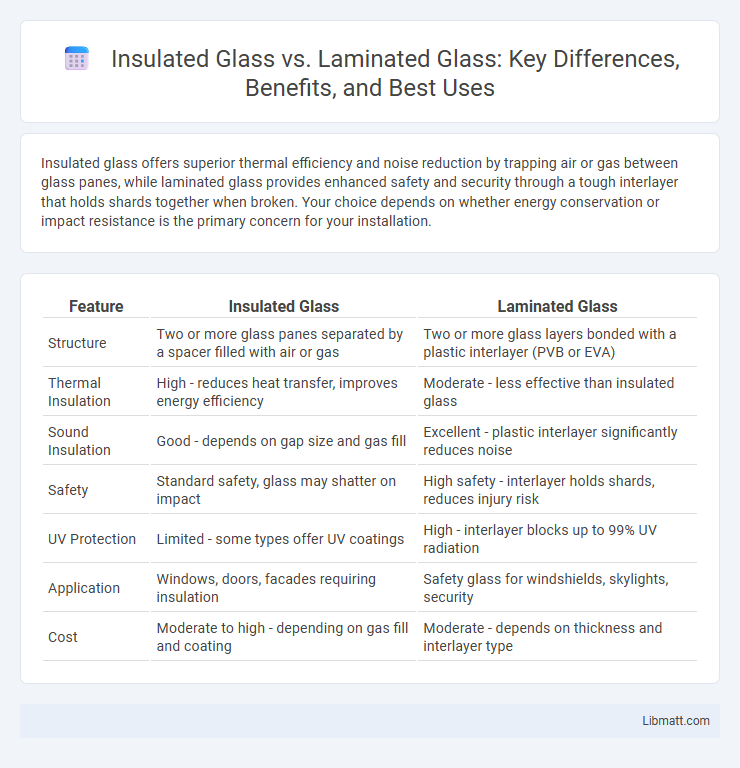Insulated glass offers superior thermal efficiency and noise reduction by trapping air or gas between glass panes, while laminated glass provides enhanced safety and security through a tough interlayer that holds shards together when broken. Your choice depends on whether energy conservation or impact resistance is the primary concern for your installation.
Table of Comparison
| Feature | Insulated Glass | Laminated Glass |
|---|---|---|
| Structure | Two or more glass panes separated by a spacer filled with air or gas | Two or more glass layers bonded with a plastic interlayer (PVB or EVA) |
| Thermal Insulation | High - reduces heat transfer, improves energy efficiency | Moderate - less effective than insulated glass |
| Sound Insulation | Good - depends on gap size and gas fill | Excellent - plastic interlayer significantly reduces noise |
| Safety | Standard safety, glass may shatter on impact | High safety - interlayer holds shards, reduces injury risk |
| UV Protection | Limited - some types offer UV coatings | High - interlayer blocks up to 99% UV radiation |
| Application | Windows, doors, facades requiring insulation | Safety glass for windshields, skylights, security |
| Cost | Moderate to high - depending on gas fill and coating | Moderate - depends on thickness and interlayer type |
Introduction to Insulated Glass and Laminated Glass
Insulated glass consists of two or more glass panes separated by a spacer and sealed to create an air or gas-filled cavity, delivering superior thermal insulation and reduced energy costs. Laminated glass features multiple layers of glass bonded with an interlayer, enhancing safety by preventing shattering and improving sound insulation. Understanding the differences in structure and performance helps you choose the ideal glazing for energy efficiency, safety, and comfort in your building.
Composition and Structure of Insulated Glass
Insulated glass consists of two or more glass panes separated by a spacer filled with air or inert gas, creating a thermal barrier that enhances energy efficiency and reduces heat transfer. The sealed structure often includes desiccants to prevent moisture buildup and fogging between the panes. Your choice of insulated glass offers superior insulation and soundproofing compared to laminated glass, which is composed of layers of glass and a plastic interlayer designed primarily for safety and impact resistance.
Composition and Structure of Laminated Glass
Laminated glass consists of two or more glass layers bonded by an interlayer, typically made of polyvinyl butyral (PVB) or ethylene-vinyl acetate (EVA), which enhances safety and sound insulation. Its sandwich-like structure prevents shattering upon impact by holding glass fragments together, making it ideal for automotive windshields and architectural applications. Unlike insulated glass, laminated glass focuses on impact resistance and security rather than thermal insulation.
Thermal Performance Comparison
Insulated glass offers superior thermal performance by featuring multiple glass panes separated by air or gas-filled spaces that reduce heat transfer and enhance energy efficiency. Laminated glass, composed of layers bonded with interlayers, provides moderate thermal insulation but mainly excels in safety and soundproofing rather than energy conservation. For climates requiring significant temperature control and energy savings, insulated glass delivers more effective thermal resistance compared to laminated glass.
Acoustic Insulation Differences
Insulated glass significantly reduces external noise by using two or more glass panes separated by an air or gas-filled space, creating an effective acoustic barrier. Laminated glass consists of a layer of PVB or ionoplast interlayer that dampens sound vibrations, providing superior soundproofing especially against high-frequency noises. Compared to insulated glass, laminated glass offers better acoustic insulation in environments with fluctuating sound levels due to its ability to absorb and dissipate sound energy more efficiently.
Safety and Security Features
Insulated glass offers enhanced thermal insulation but provides limited impact resistance compared to laminated glass, which incorporates a durable interlayer that holds shattered glass together, significantly improving safety and security. Laminated glass is designed to resist forced entry and reduce the risk of injury from broken glass, making it ideal for areas requiring added protection. Your choice should prioritize laminated glass when safety and security are top concerns, especially in high-risk or vulnerable locations.
Energy Efficiency Analysis
Insulated glass significantly enhances energy efficiency by reducing heat transfer through its multiple layers separated by insulating gas, effectively maintaining indoor temperature and lowering energy costs. Laminated glass primarily improves safety and sound insulation but offers limited thermal insulation compared to insulated glass. For maximizing Your building's energy performance and reducing heating and cooling expenses, insulated glass is the optimal choice.
Durability and Maintenance Requirements
Insulated glass offers enhanced durability due to its multi-pane construction and inert gas fill, which improves resistance to temperature fluctuations and reduces condensation, minimizing maintenance needs over time. Laminated glass features a durable interlayer that holds fragments together upon impact, providing superior safety and resistance to shattering but may require periodic inspection to ensure the integrity of the interlayer and sealant. Both types demand proper installation and occasional cleaning, but insulated glass generally requires less frequent maintenance compared to laminated glass, which may be more susceptible to delamination in harsh environments.
Suitable Applications for Each Glass Type
Insulated glass is ideal for energy-efficient windows in residential and commercial buildings, providing superior thermal insulation and noise reduction. Laminated glass excels in safety applications such as automotive windshields, skylights, and glass doors, where impact resistance and shatter containment are critical. Each glass type serves distinct purposes based on thermal performance and security requirements.
Cost Considerations and Value
Insulated glass typically offers higher upfront costs due to its dual-pane construction and gas fill but provides superior energy efficiency that can reduce heating and cooling expenses over time. Laminated glass, while often less expensive initially, enhances safety and soundproofing, adding value in security-conscious or noise-sensitive environments. Evaluating long-term savings versus immediate budget constraints helps determine the optimal glass choice for cost-effectiveness and functional benefits.
insulated glass vs laminated glass Infographic

 libmatt.com
libmatt.com